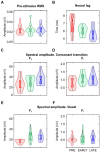The frequency-following response in late preterm neonates: a pilot study
- PMID: 38784610
- PMCID: PMC11112609
- DOI: 10.3389/fpsyg.2024.1341171
The frequency-following response in late preterm neonates: a pilot study
Abstract
Introduction: Infants born very early preterm are at high risk of language delays. However, less is known about the consequences of late prematurity. Hence, the aim of the present study is to characterize the neural encoding of speech sounds in late preterm neonates in comparison with those born at term.
Methods: The speech-evoked frequency-following response (FFR) was recorded to a consonant-vowel stimulus /da/ in 36 neonates in three different groups: 12 preterm neonates [mean gestational age (GA) 36.05 weeks], 12 "early term neonates" (mean GA 38.3 weeks), and "late term neonates" (mean GA 41.01 weeks).
Results: From the FFR recordings, a delayed neural response and a weaker stimulus F0 encoding in premature neonates compared to neonates born at term was observed. No differences in the response time onset nor in stimulus F0 encoding were observed between the two groups of neonates born at term. No differences between the three groups were observed in the neural encoding of the stimulus temporal fine structure.
Discussion: These results highlight alterations in the neural encoding of speech sounds related to prematurity, which were present for the stimulus F0 but not for its temporal fine structure.
Keywords: FFR; infants; language; preterm; speech-ABR.
Copyright © 2024 Ribas-Prats, Arenillas-Alcón, Martínez, Gómez-Roig and Escera.
Conflict of interest statement
The authors declare that the research was conducted in the absence of any commercial or financial relationships that could be construed as a potential conflict of interest. The author(s) declared that they were an editorial board member of Frontiers, at the time of submission. This had no impact on the peer review process and the final decision.
Figures



Similar articles
-
Relationships between click auditory brainstem response and speech frequency following response with development in infants born preterm.Hear Res. 2021 Aug;407:108277. doi: 10.1016/j.heares.2021.108277. Epub 2021 May 23. Hear Res. 2021. PMID: 34091212
-
Deficient neural encoding of speech sounds in term neonates born after fetal growth restriction.Dev Sci. 2022 May;25(3):e13189. doi: 10.1111/desc.13189. Epub 2021 Nov 18. Dev Sci. 2022. PMID: 34758093
-
Prenatal daily musical exposure is associated with enhanced neural representation of speech fundamental frequency: Evidence from neonatal frequency-following responses.Dev Sci. 2023 Sep;26(5):e13362. doi: 10.1111/desc.13362. Epub 2023 Jan 5. Dev Sci. 2023. PMID: 36550689
-
Ontogeny of autonomic regulation in late preterm infants born at 34-37 weeks postmenstrual age.Semin Perinatol. 2006 Apr;30(2):73-6. doi: 10.1053/j.semperi.2006.02.005. Semin Perinatol. 2006. PMID: 16731280 Review.
-
Neonatal Frequency-Following Responses: A Methodological Framework for Clinical Applications.Semin Hear. 2022 Oct 26;43(3):162-176. doi: 10.1055/s-0042-1756162. eCollection 2022 Aug. Semin Hear. 2022. PMID: 36313048 Free PMC article. Review.
References
-
- Aeby A., De Tiège X., Creuzil M., David P., Balériaux D., Van Overmeire B., et al. . (2013). Language development at 2 years is correlated to brain microstructure in the left superior temporal gyrus at term equivalent age: a diffusion tensor imaging study. NeuroImage. 78, 145–151. doi: 10.1016/j.neuroimage.2013.03.076, PMID: - DOI - PubMed
-
- American Academy of Pediatrics, Joint Committee on Infant Hearing (2019). Year 2019 position statement: principles and guidelines for early hearing detection and intervention programs. J. Early Hear. Detect. Intervent. 4, 1–44. doi: 10.15142/fptk-b74 - DOI
LinkOut - more resources
Full Text Sources

